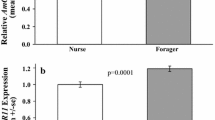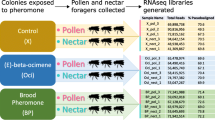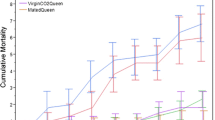Abstract
Pheromones cause dramatic changes in behavior and physiology, and are critical for honey bee colony organization. Queen mandibular pheromone (QMP) regulates multiple behaviors in worker bees (Slessor et al. in J Chem Ecol 31(11):2731–2745, 2005). We also identified genes whose brain expression levels were altered by exposure to QMP (Grozinger et al. in Proc Natl Acad Sci USA 100(Suppl 2):14519–14525, 2003). Krüppel-homolog 1 (Kr-h1) RNA levels were significantly downregulated by QMP, and were higher in foragers than in nurses (Whitfield et al. in Science 302(5643):296–299, 2003). Here we report on results of behavioral and pharmacological experiments that characterize factors regulating expression of Kr-h1. Foragers have higher brain levels of Kr-h1 than in-hive bees, regardless of age and pheromone exposure. Furthermore, forager Kr-h1 levels were not affected by QMP. Since the onset of foraging is caused, in part, by increasing juvenile hormone blood titers and brain octopamine levels, we investigated the effects of octopamine and methoprene (a juvenile hormone analog) on Kr-h1 expression. Methoprene produced a marginal (not significant) increase in Kr-h1 expression, but Kr-h1 brain levels in methoprene-treated bees were no longer downregulated by QMP. Octopamine did not modulate Kr-h1 expression. Our results demonstrate that the gene expression response to QMP is not hard-wired in the brain but is instead dependent on worker behavioral state.





Similar content being viewed by others
References
Amdam GV, Omholt SW (2003) The hive bee to forager transition in honeybee colonies: the double repressor hypothesis. J Theor Biol 223(4):451–464
Amdam GV, Aase AL, Seehuus SC, Kim Fondrk M, Norberg K et al (2005) Social reversal of immunosenescence in honey bee workers. Exp Gerontol 40(12):939–947
Anton S, Gadenne C (1999) Effect of juvenile hormone on the central nervous processing of sex pheromone in an insect. Proc Natl Acad Sci USA 96(10):5764–5767
Barron AB, Schulz DJ, Robinson GE (2002) Octopamine modulates responsiveness to foraging-related stimuli in honey bees (Apis mellifera). J Comp Physiol A Neuroethol Sens Neural Behav Physiol 188(8):603–610
Barron AB, Maleszka J, Vander Meer RK, Robinson GE, Maleszka R (2006) Comparing the efficiency of injection, feeding and topical application methods for pharmacological treatment of honey bees. J Ins Phys (in press)
Beck Y, Pecasse F, Richards G (2004) Kruppel-homolog is essential for the coordination of regulatory gene hierarchies in early Drosophila development. Dev Biol 268(1):64–75
Ben-Shahar Y, Robinson GE (2001) Satiation differentially affects performance in a learning assay by nurse and forager honey bees. J Comp Physiol A Neuroethol Sens Neural Behav Physiol 187(11):891–899
Ben-Shahar Y, Robichon A, Sokolowski MB, Robinson GE (2002) Influence of gene action across different time scales on behavior. Science 296(5568):741–744
Ben-Shahar Y, Leung HT, Pak WL, Sokolowski MB, Robinson GE (2003) cGMP-dependent changes in phototaxis: a possible role for the foraging gene in honey bee division of labor. J Exp Biol 206(Pt 14):2507–2515
Bloch G, Toma DP, Robinson GE (2001) Behavioral rhythmicity, age, division of labor and period expression in the honey bee brain. J Biol Rhythms 16(5):444–456
Bloch G, Sullivan JP, Robinson GE (2002) Juvenile hormone and circadian locomotor activity in the honey bee Apis mellifera. J Insect Physiol 48(12):1123–1131
Burns MJ, Nixon GJ, Foy CA, Harris N (2005) Standardisation of data from real-time quantitative PCR methods—evaluation of outliers and comparison of calibration curves. BMC Biotechnol 5:31
Dhadialla TS, Carlson GR, Le DP (1998) New insecticides with ecdysteroidal and juvenile hormone activity. Annu Rev Entomol 43:545–569
Fahrbach SE, Giray T, Farris SM, Robinson GE (1997) Expansion of the neuropil of the mushroom bodies in male honey bees is coincident with initiation of flight. Neurosci Lett 236(3):135–138
Grozinger CM, Pfischer P, Hampton JE (2007) Uncoupling primer and releaser responses to pheromone in the honey bee brain. Naturwissenschaften (in press)
Grozinger CM, Sharabash NM, Whitfield CW, Robinson GE (2003) Pheromone-mediated gene expression in the honey bee brain. Proc Natl Acad Sci USA 100(Suppl 2):14519–14525
Grubbs FE, Beck G (1972) Extension of sample sizes and percentage points for significance tests of outlying observations. Technometerics 14(4):847–854
Hartfelder K, Bitondi MM, Santana WC, Simoes ZL (2002) Ecdysteroid titer and reproduction in queens and workers of the honey bee and of a stingless bee: loss of ecdysteroid function at increasing levels of sociality? Insect Biochem Mol Biol 32(2):211–216
Hoover SE, Keeling CI, Winston ML, Slessor KN (2003) The effect of queen pheromones on worker honey bee ovary development. Naturwissenschaften 90(10):477–480
Kaatz H-H, Hildebrandt H, Engels W (1992) Primer effect of queen pheromone on juvenile hormone biosynthesis in adult worker honey bees. J Comp Physiol [B](162):588–592
Keverne EB (2005) Odor here, odor there: chemosensation and reproductive function. Nat Neurosci 8(12):1637–1638
Laidlaw J, H. H. (1987) Instrumental insemination of honeybee queens: its origin and development. Bee World 68:17–38
McGovern VL, Pacak CA, Sewell ST, Turski ML, Seeger MA (2003) A targeted gain of function screen in the embryonic CNS of Drosophila. Mech Dev 120(10):1193–1207
Pankiw T, Huang Z, Winston ML, Robinson GE (1998) Queen mandibular gland pheromone influences worker honey bee (Apis mellifera L.) foraging ontogeny and juvenile hormone titers. J Insect Physiol 44(7–8):685–692
Pecasse F, Beck Y, Ruiz C, Richards G (2000) Kruppel-homolog, a stage-specific modulator of the prepupal ecdysone response, is essential for Drosophila metamorphosis. Dev Biol 221(1):53–67
Pham-Delegue MH, Trouiller J, Caillaud CM, Roger B, Masson C (1993) Effect of queen pheromone on worker bees of different ages: behavioral and electrophysiological responses. Apidologie 24:267–281
Rachinsky A (1994) Octopamine and serotonin influence on corpora allata activity in honey bee (Apis mellifera) larvae. J Ins Phys 40(7):549–554
Robinson GE (1987) Modulation of alarm pheromone perception in the honey bee: evidence for division of labor based on homonally regulated response thresholds. J Comp Physiol 160:613–619
Robinson GE, Page RE Jr (1988) Genetic determination of guarding and undertaking in honey-bee colonies. Nature 333:356–358
Robinson GE, Ben-Shahar Y (2002) Social behavior and comparative genomics: new genes or new gene regulation? Genes Brain Behav 1(4):197–203
Robinson GE, Page RE Jr, Fondrk MK (1990) Intracolonial behavioral variation in worker oviposition, oophagy, and larval care in queenless honey bee colonies. Behav Ecol Sociobiol 26(5):315–323
Robinson GE, Grozinger CM, Whitfield CW (2005) Sociogenomics: social life in molecular terms. Nat Rev Genet 6(4):257–270
Robinson GE, Strambi C, Strambi A, Huang ZY (1992) Reproduction in worker honey bees is associated with low juvenile hormone titers and rates of biosynthesis. Gen Comp Endocrinol 87(3):471–480
Schulz DJ, Robinson GE (1999) Biogenic amines and division of labor in honey bee colonies: behaviorally related changes in the antennal lobes and age-related changes in the mushroom bodies. J Comp Physiol [A] 184(5):481–488
Schulz DJ, Sullivan JP, Robinson GE (2002) Juvenile hormone and octopamine in the regulation of division of labor in honey bee colonies. Horm Behav 42(2):222–231
Skals N, Anderson P, Kanneworff M, Lofstedt C, Surlykke A (2005) Her odours make him deaf: crossmodal modulation of olfaction and hearing in a male moth. J Exp Biol 208(Pt 4):595–601
Slessor KN, Winston ML, Le Conte Y (2005) Pheromone communication in the honeybee (Apis mellifera L.). J Chem Ecol 31(11):2731–2745
Slessor KN, Kaminski L-A, King GGS, Borden JH, Winston ML (1988) Semiochemical basis of the retinue response to queen honey bees. Nature 332:354–356
Toth AL, Kantarovich S, Meisel AF, Robinson GE (2005) Nutritional status influences socially regulated foraging ontogeny in honey bees. J Exp Biol 208(Pt 24):4641–4649
Whitfield CW, Cziko AM, Robinson GE (2003) Gene expression profiles in the brain predict behavior in individual honey bees. Science 302(5643):296–299
Whitfield CW, Ben-Shahar Y, Brillet C, Leoncini I, Crauser D et al (2006) Genomic dissection of behavioral maturation in the honey bee. Proc Natl Acad Sci USA 103(44):16068–16075
Winston ML (1987) The biology of the honey bee. Harvard University Press, Cambridge, p 281
Wyatt TD (2003) Pheromones and animal behavior: communication by smell and taste. Cambridge University Press, Cambridge, p 408
Acknowledgments
The authors would like to thank Karen Pruiett for expert assistance with the bees, Klara Kim for technical assistance, Cavell Brownie, Kim Hughes and Sandra Rodriguez-Zas for statistical advice, and Robert Anholt, Susan Fahrbach and two anonymous reviewers for critical reading of the manuscript. This work was supported by a Beckman Post-doctoral Fellowship to CMG, an National Institutes of Deafness and Communications Disorders grant (1 R01 DC006395-01A1) and a USDA-NRI grant (AG2003-35302-13490) to GER. The authors declare that the experiments comply with the National Institutes of Health animal care principles and with the current laws of the USA.
Author information
Authors and Affiliations
Corresponding author
Rights and permissions
About this article
Cite this article
Grozinger, C.M., Robinson, G.E. Endocrine modulation of a pheromone-responsive gene in the honey bee brain. J Comp Physiol A 193, 461–470 (2007). https://doi.org/10.1007/s00359-006-0202-x
Received:
Revised:
Accepted:
Published:
Issue Date:
DOI: https://doi.org/10.1007/s00359-006-0202-x




